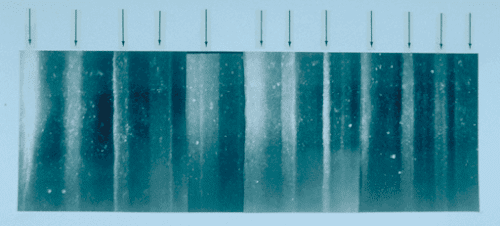Sound As Information
 |
| Ice Core Layers |
Happy 10th anniversary of the World Listening Project!
2010 was the first year that I got my first pair of ear mics and a portable recorder. What I was most interested in was finding places that had embedded Keynotes or Soundmarks (continuous pitched elements in a place) which I wanted to integrate into my ambient music. Field recordings are actually a great way to listen to the environment because the recording apparatus has done some of that listening for you: when you come back and listen to the recording, you hear things that you missed when you were there. It works the same way in photography, where you come back home and look at the images and you see other things that were outside the frame that you didn't notice when you were attempting to get the shot.
Even before I was doing field recording myself, I was interested in using field recordings made by others. I had a friend that visited various parts of the globe, one of them Costa Rica. I had taken his field recordings and made an immersive sound environment to be played over multiple audio systems which I called Atmosphere Generation. The randomized playing of the field recordings created an artificial soundscape around the room.
As a musician first and foremost, I am typically focused on music fundamentals and tend to gravitate towards composition, songwriting, production, and performance. But over the years I have come to fully appreciate the totality of acoustical environments and have thought more about how to integrate them, into at least my ambient works as spatio-temporal layers. (See Eonothem of Sound). It has made me more attentive to subtle temporal changes on the periphery; We don't always notice what is changing but it is, in fact, changing very slowly.
If we understand sound as being a part of a larger system, that larger system can include things beyond our ken, which we can now understand using new technologies that extend hearing beyond thresholds by analyzing differences in sounds recorded say 40 years ago to the now, not with our ears, but with data analysis. This may sound dry and unemotional, but this is how we understand changes in the environment. Using the corollary of climate change, it is not by going to the Arctic to see the glaciers receding, but by relying on the scientific data that has been collected there.
Listening is not just about sound but about informational contexts, It enriches perception over time so you notice things changing.
I recall back in the 1980s when I started commuting into the city to attend college, a typical sound of a city street typically included the frequent squeaking of brakes--something I had not experienced on quiet suburban streets. Over time, technology has changed the nature of the disc brake so that sound is becoming obsolete. When sonic changes are very gradual, we don't notice them. Or if there is a constant flat-line sound in some environments that we experience on a daily basis over many years, we begin to tune them out. Similarly, people that live in the most idyllic locations tend to become inured to them over time, and they essentially become a kind of wallpaper. This is why we need a more mindful awareness in both the visual and aural realms to experience them more in the flow of our daily lives.
Audio Snapshots (YouTube)
Audio Snapshots (Audio Files)
Music For Places (Music Videos)


Comments